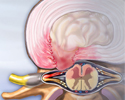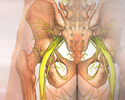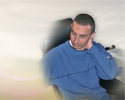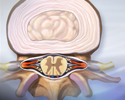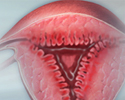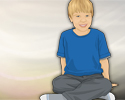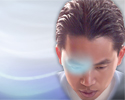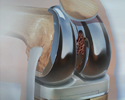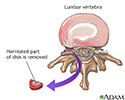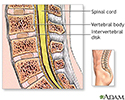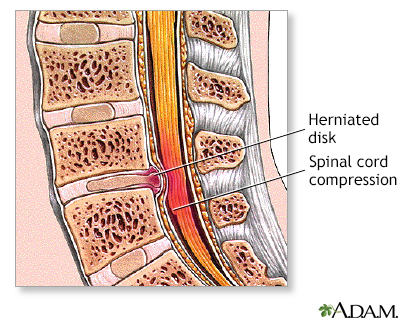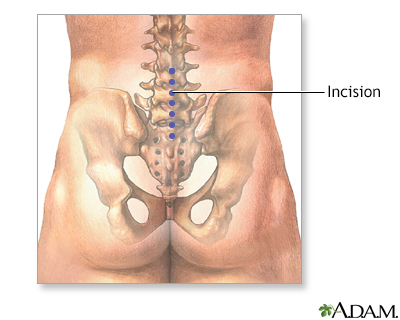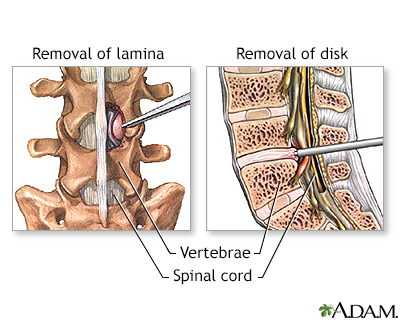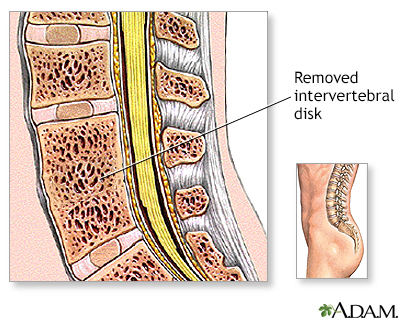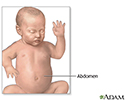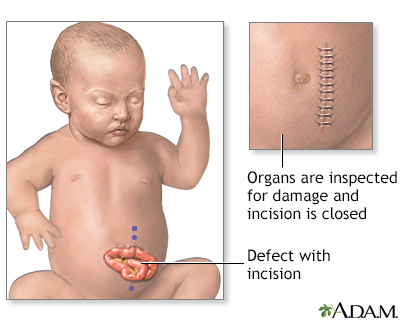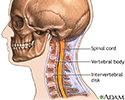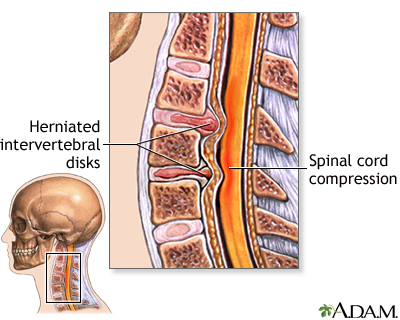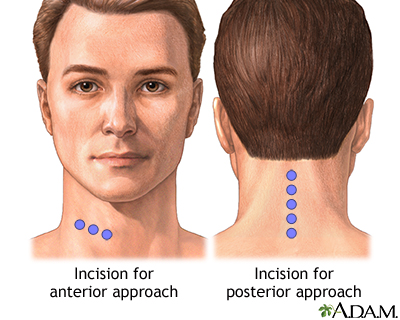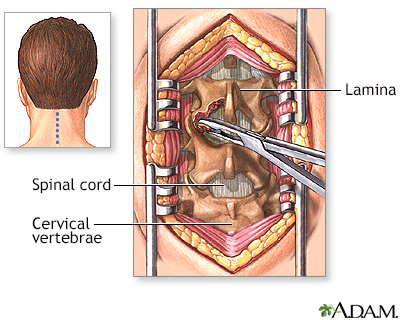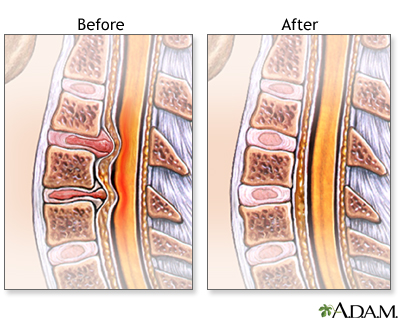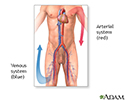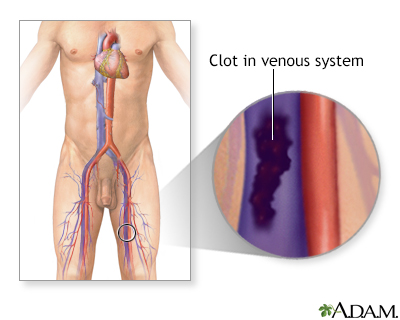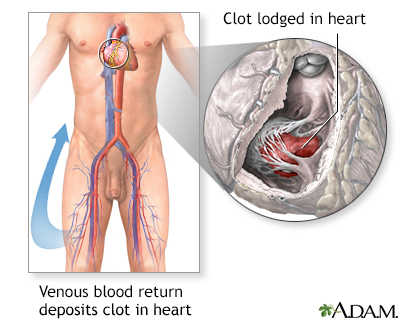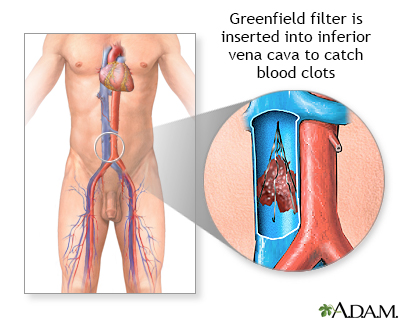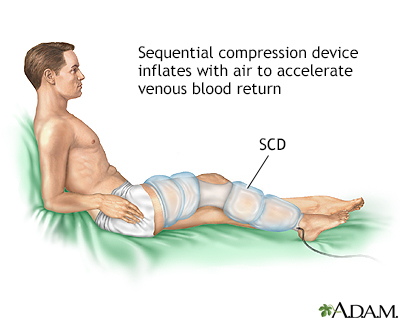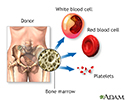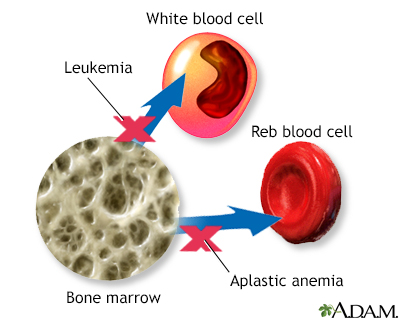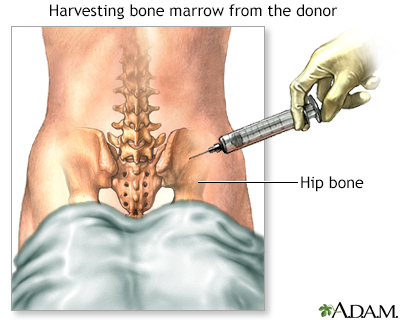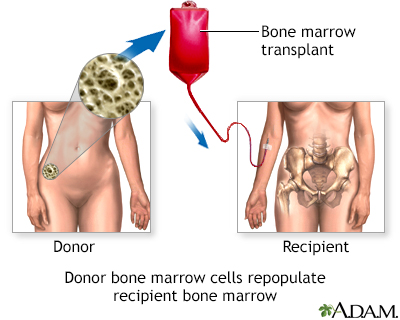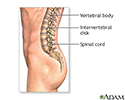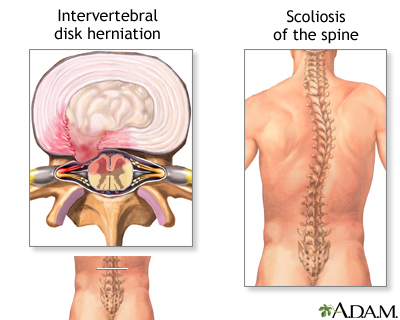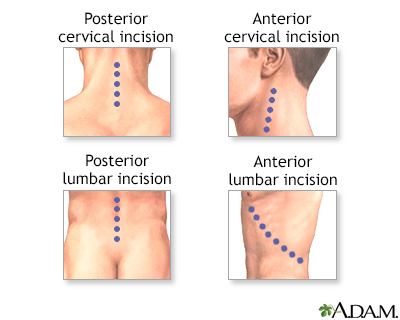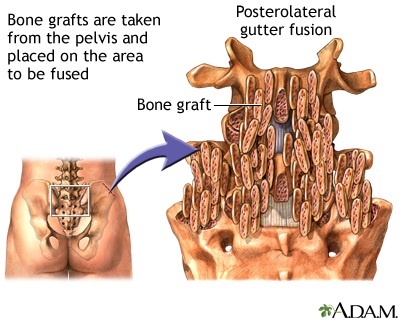Cognitive behavioral therapy for back pain
Nonspecific back pain - cognitive behavioral; Backache - chronic - cognitive behavioral; Lumbar pain - chronic - cognitive behavioral; Pain - back - chronic - cognitive behavioral; Chronic back pain - low - cognitive behavioralNonspecific back pain - cognitive behavioral; Backache - chronic - cognitive behavioral; Lumbar pain - chronic - cognitive behavioral; Pain - back - chronic - cognitive behavioral; Chronic back pain - low - cognitive behavioral
The Basics
A Closer Look
- Back pain and sciatica - InDepth (Detailed Report)
- Fibromyalgia - InDepth (Detailed Report)
- Tension headache (Alternative Medicine)
- Depression - InDepth (Detailed Report)
- Temporomandibular joint dysfunction (Alternative Medicine)
- Exercise - InDepth (Detailed Report)
- Headaches - tension - InDepth (Detailed Report)
- Migraine headaches - InDepth (Detailed Report)
- Headaches - cluster - InDepth (Detailed Report)
- Sickle cell disease - InDepth (Detailed Report)
Self Care
Herniated disk - Animation
Herniated disk
Animation
Sciatica - Animation
Sciatica
Animation
Neck pain - Animation
Neck pain
Animation
Spinal stenosis - Animation
Spinal stenosis
Animation
Endometriosis - Animation
Endometriosis
Animation
Depression - Animation
Depression
Animation
Attention deficit hyperactivity disorder (ADHD) - Animation
Attention deficit hyperactivity disorder (ADHD)
Animation
Cluster headache - Animation
Cluster headache
Animation
Knee joint replacement - Animation
Knee joint replacement
Animation
Herniated disk repair
When the soft, gelatinous central portion of an intervertebral disk is forced through a weakened part of a disk, it is a condition known as a slipped disk. Most herniation takes place in the lumbar area of the spine, and it is one of the most common causes of lower back pain. The mainstay of treatment for herniated disks is an initial period of rest with pain and anti-inflammatory medications followed by physical therapy. If pain and symptoms persist, surgery to remove the herniated portion of the intervertebral disk is recommended.
Herniated disk repair
illustration
Lumbar spinal surgery - series
Presentation
Gastroschisis repair - series
Presentation
Spinal surgery - cervical - series
Presentation
Venous thrombosis - series
Presentation
Bone-marrow transplant - series
Presentation
Lumbar spinal surgery - series
Presentation
Bone-marrow transplant - series
Presentation
Spinal fusion - series
Presentation
Herniated disk - Animation
You might have heard a friend say that they have "slipped a disk. " Or, you may have slipped a disk yourself during an overly strenuous workout, or by straining while lifting something heavy. A slipped disk can be painful, so painful, in fact, that you can barely move. But what exactly is a slipped disk? And what can you do about it if you have one?This is your spine. In between the bones, which are called vertebrae, are little cushioning disks. These disks not only allow you to bend and move but also prevent your bones from rubbing against each other. Sometimes an injury can push a disk out of place, producing a bulge. This bulge is called a herniated disk. Or, a disk may break open. When a disk moves, it puts pressure on nearby nerves, and that's when you start to feel pain. Most slipped disks are found in the lower back or lumbar region, although you can also have one in your neck, or cervical region. When you have a slipped disk, you'll hurt, but often just on one side of your body. If the disk is in your lower back, you may feel a sharp pain in one part of your leg, hip, or buttocks. Your leg may also feel weaker than usual. If the disk is in your neck, the pain and numbness can stretch all the way from your neck down to your shoulder and arm. You may notice that it hurts even more when you stand for a long period of time, or if you sneeze, cough, or laugh. So, how do you treat a slipped disk?First your doctor will want to make sure that you actually have a slipped disk. To find out, the doctor will check your muscle strength, feeling, and reflexes, and have you move in different ways, for example, by bending, standing, and walking. You may also have a scan to find the exact location of the slipped disk. While bed rest was once the standard therapy for low back pain, studies show that for most people it does not help and may even make the situation worse. Rapid return to healthy normal activity is usually best, being careful not to put too much stress on the back. While you're doing that, you can take medicines like ibuprofen or aspirin to relieve the pain. Muscle relaxants may also help. Acupuncture, massage, and yoga have also been shown to be affective in some studies. Physical therapy may be helpful after the first two or three weeks. It can help strengthen the muscles of your spine, and teach you how to move properly so you don't injure yourself again. If these measures don't help, your doctor may suggest getting steroid injections into the area where you slipped the disk, to reduce pain and relieve swelling. As a last resort when all other treatments have failed, you may have a surgery called a diskectomy to remove the damaged disk. You may be in pain now, but don't despair, with treatment it should ease. Realize that it may take a few months before you're back to your old self. Don't try to overdo it by bending or doing any heavy lifting. You'll just wind up back on your couch, hurting again.
Sciatica - Animation
Sciatica. It's not a new trendy restaurant in New York or LA, or a new SciFi program on your favorite cable channel. Sciatica is something much less sexy. Sciatica might actually be the cause of that the sharp pain you occasionally feel in your backside, or traveling down your hip or leg. What is sciatica? What does this pain mean? Sciatica occurs when there is pressure or damage to the Sciatic nerve. This large nerve starts in your lower spine and runs down the back of each leg. It controls the muscles of the back of your knee and lower leg. It also provides sensation to the back of your thigh, part of your lower leg, and the sole of your foot. Sciatica is usually caused by another problem, such as a slipped disk, spinal stenosis or narrowing of the spinal column, piriformis syndrome, the narrowing of muscle in your buttocks, a pelvic injury or fracture, and perhaps even tumors. Your pain may feel like a mild tingling, a dull ache, or a burning sensation. Sometimes the pain can be so bad you might not be able to move. The pain will usually occur on one side, perhaps as a sharp pain in one part of your hip or leg, or maybe you will notice the numbness. The pain may get worse after you stand or sit, at night, when you sneeze, cough, or laugh, or when you bend backwards or walk forward. For treatment, your doctor will perform a careful physical exam. Your doctor might find you have weakness when you bend your knee or move your foot, trouble bending your foot inward or downward, weak reflexes, or pain when you lift your leg straight up off the examination table while lying down. Your doctor may also do other tests to find what's causing your sciatica, including blood tests, x-rays, and other imaging tests. Treatment will focus on what causes your sciatica. Sometimes you may not need treatment because your pain will go away on its own. Your doctor will likely first recommend that you take steps to calm your symptoms and reduce inflammation, such as applying heat or ice to the painful area. You might try ice for the first 48 to 72 hours after you feel pain, then use heat afterwards. Your doctor might also tell you to take over-the-counter pain relievers. If conservative measures don't help your problem, your doctor may recommend you have injections to reduce inflammation around your sciatic nerve and other medicines to reduce the stabbing pain. Physical therapy may be a viable option, so talk to your healthcare provider about this option. Whatever you do, don't stay in bed all day. You need to reduce your normal activity for the first few days after you start having pain, but getting no activity will only make your pain worse. After a few days, try gradually returning to your normal routine. But, avoid heavy lifting or twisting your back for at least 6 weeks. Make sure you start exercising again though after 2 to 3 weeks. Remember, include exercises to strengthen your abdomen or belly and improve the flexibility of your spine.
Neck pain - Animation
Your neck is sore. It hurts to move your head. Are you sleeping wrong, is it stress, or a result of climbing that ladder to clean your gutters? Let's get to the bottom of those real "pains in your neck. "When your neck is sore, you may have trouble moving it, especially to one side. Many people describe this as having a stiff neck. If neck pain involves nerves, such as a muscle spasm pinching on a nerve or a slipped disk pressing on a nerve, you may feel numbness, tingling, or weakness in your arm, hand, or elsewhere. A common cause of neck pain is muscle strain or tension. Usually, everyday activities are to blame. Such activities include bending over a desk for hours hunching in place, having poor posture while watching TV or reading, placing your computer monitor too high or too low, sleeping in an uncomfortable position, or twisting and turning your neck in a jarring manner while exercising. Usually, you can treat minor neck pain at home. Simple posture improvements are a great place to start, sitting straight with shoulders held back, driving with arms on armrests, and avoiding carrying shoulder bags. Take breaks when sitting in front of video displays or holding a telephone. For pain, you might try over-the-counter pain relievers such as Advil or Tylenol. And low level laser therapy can be very effective. Physical therapy can be great for treating or preventing the recurrence of neck pain. Slow range of motion exercises, moving your head up and down, side to side from ear to ear, can gently stretch your neck muscles. Applying heat beforehand may help. Good sleep position is especially important with the head aligned with the body. You can try sleeping with a special neck pillow for that. You may want to see a doctor if your symptoms linger for longer than a week of self care, or if you have numbness, tingling, or weakness in your arm or hand, or if your pain was caused by a fall, blow, or injury. If the pain is due to a muscle spasm or a pinched nerve, your doctor may prescribe a muscle relaxant or a tricyclic antidepressant, and possibly a more powerful pain reliever than you were taking at home. You may be referred to a neurologist if he suspects any nerve damage in your neck. You can help prevent neck pain or keep it from coming back in many ways. Use relaxation techniques and regular exercise to prevent unwanted stress and tension to your neck muscles. Learn stretching exercises for your neck and upper body, stretch every day, before and especially after exercise. Use good posture, especially if you sit at a desk all day, keep your back supported, adjust your computer monitor to eye level, so you don't have to continually look up or down. Talk to your doctor if pain persists, you do not want to go through life with a real pain in the neck.
Spinal stenosis - Animation
When you get up from a chair or take a walk, do you feel pain in your back, legs, shoulders, or arms? Do your arms or legs feel weaker than usual? If so, believe it or not, the problem could be in your spine, and the cause, a condition known as condition called spinal stenosis. Your spine is the column of bones that runs up the center of your back. It not only helps you stay upright but also flexes to allow you to bend and twist. These bones are called vertebrae, which are separated by spongy disks that cushion the bones so they don't rub against each other. As you get older, these spongy disks start to shrink, while the ligaments of your spine may swell up, due to arthritis. Together, these two actions narrow and put pressure on your spinal cord, or its exiting nerves, which is called spinal stenosis. You can also get spinal stenosis if you've had an injury like a slipped disk. So, how is spinal stenosis diagnosed?During an exam, your doctor will try to find the source of your pain or weakness by having you go through different motions. You'll sit, stand, walk, bend forward and backward, and lift your legs. The doctor will probably also test your reflexes with a rubber hammer, and use a feather or pin to see whether you've lost any feeling in feet and legs. Although there are surgical procedures to relieve the pressure on your spinal cord, trying a few measures at home first can help you avoid surgery. Physical therapy will teach you exercises and stretches to strengthen your muscles and improve your range of motion. Massage and acupuncture can be helpful for relieving back and neck pain. Putting heat or ice on a painful area can also help. Or, your doctor may recommend taking anti-inflammatory or pain-relieving medications. You can probably stay active with spinal stenosis, if you follow your doctor's recommendations and don't try to overdo it. Maybe you need to walk instead of jog, or play fewer holes on the golf course. If treatments at home don't work, surgery can often help relieve your symptoms, although it doesn't cure the condition and your pain may come back afterward. One of the biggest worries with spinal stenosis is numbness. If you can't feel pain in your legs or feet, you may get injured and not even realize it. An untreated injury can lead to an infection. Make sure to call your doctor if you have any numbness, pain, or other symptoms of spinal stenosis, especially trouble balancing or difficulty urinating or having a bowel movement. Take care of your spine. It's the only one you've got.
Endometriosis - Animation
A common gynecological problem in women occurs when cells that are supposed to form in the uterus of a woman, attach themselves to tissue in other places of the body, causing pain, irregular bleeding, and problems with getting pregnant, or infertility. Let's talk about endometriosis in a little more detail. Every month, a woman's ovaries produce hormones that tell the cells lining the uterus, or womb, to swell and thicken. The body removes these extra cells from the womb lining, or endometrium, when you get your period. But if these cells, called endometrial cells, implant and grow outside the uterus, endometriosis results. The growths are called endometrial tissue implants. Women with endometriosis typically have tissue implants on the ovaries, or bowel, rectum, bladder, or on the lining of the pelvic area. We don't know what causes endometriosis. One theory is that the endometrial cells that shed when you get your period travel backwards through the fallopian tubes into the pelvis, where they implant and grow. This is called retrograde menstruation. This backward menstrual flow occurs in many women, but many think the immune system may also be different in women with endometriosis. Symptoms of endometriosis include painful periods, pain in your lower belly before and during menstruation, cramps before and during menstruation, pain during sex, painful bowel movements, as well as pelvic or lower back pain. To treat endometriosis. . . The goal of treatment is to improve pelvic pain, reduce pelvic masses, or improve fertility. If you have mild symptoms and do not want to have children, you may choose to have regular exams every 6 to 12 months so your doctor can make sure the disease isn't getting worse. Treatment options also include pain medicines, hormone medicines to stop the disease from getting worse, or surgery to remove the area of endometriosis or even the entire uterus and ovaries if you have severe pain that does not get better with other treatments. Hormone therapy doesn't cure endometriosis, but it can relieve some or all of your symptoms. Unfortunately, removal of the uterus, fallopian tubes, and both ovaries may eliminate symptoms, but it also eliminates fertility. A combination of limited surgery and assisted reproduction techniques may improve fertility. So, if you have any questions about endometriosis, please see your doctor.
Depression - Animation
If you often feel sad, blue, unhappy, miserable, or down in the dumps, you may have depression. Let's talk about depression, and what you can do to get out of your funk. Depression often runs in families. This may be due to your genes, passed down by your parents and grandparents, the behaviors you learn at home, or both. Even if your genetic makeup makes you more likely to develop depression, a stressful or unhappy life event may trigger the depression. Depression can have many causes, including internal factors like genetics, or negative personality. External factors, substance misuse, or trauma and loss. Common triggers include alcohol or drug use, and medical problems long-term pain, cancer or even sleeping problems. Stressful life events, like getting laid off, abuse at home or on the job, neglect, family problems, death of a loved one, or divorce, can send someone spiraling into depression. There are three main types of depression, major depression, atypical depression and Dysthymia. To be diagnosed with major depression, you must demonstrate 5 or more of the primary symptoms for at least two weeks. Atypical depression occurs in about a third of patients with depression, with symptoms including overeating, oversleeping, and feeling like you are weighed down. Dysthymia is a milder form of depression that can last for years if not treated. Other forms include the depression that is part of bipolar disorder, postpartum depression, occurring after a woman gives birth, Premenstrual dysphoric disorder, occurring 1 week before a woman's menstrual period and seasonal affective disorder, occurring in both males and females during the fall and winter seasons. No matter what type of depression you have and how severe it is, some self-care steps can help. Get enough sleep if you can, exercise regularly, and follow a healthy, nutritious diet. Avoid alcohol and recreational drugs. Get involved in activities that make you happy and spend time with family and friends. If you are religious, talk to a clergy member. Consider meditation, tai chi, or other relaxation methods. If you are depressed for 2 weeks or longer, contact your doctor or other health professional before your symptoms get worse. Treatment will depend on your symptoms. For mild depression, counseling and self-care may be enough. Either psychotherapy or antidepressant medicines may help, but they are often more effective when combined. Vigorous exercise and light therapy could offer significant benefit alone or in combination. Healthy lifestyle habits can help prevent and treat depression, and reduce the chances of it coming back. Talk therapy and antidepressant medication can also make you less likely to become depressed again. In fact, talk therapy may help you through times of grief, stress, or low mood. In general, staying active, making a difference in the life of others, getting outside and keeping in close contact with other people is important for preventing depression.
Attention deficit hyperactivity disorder (ADHD) - Animation
A lot of kids are what we call "high energy. " They seem to bounce off walls and find it impossible to sit still. For some kids, though, overactive and impulsive behaviors are severe enough to affect their schoolwork and home life. These kids may have a condition called Attention Deficit Hyperactivity Disorder, or ADHD. ADHD is very common. In fact, it's the most common behavioral problem in children. About 3 to 5% of school-aged kids are diagnosed with ADHD. Most of them are boys. So, what causes ADHD?Doctors aren't sure exactly what causes ADHD, though we do know some things that contribute. And we do know that the brain looks different in kids with this condition than it does in kids without the disorder. Most kids with ADHD also have other problems with behavior, depression, sleeping, or learning. How do you know for sure that your child has ADHD?There are three types of ADHD: inattentive, hyperactive, and impulsive. Kids with the inattentive type get distracted easily. You'll find them staring out of the window in class instead of paying attention. They tend to lose their pens and pencils, and can't seem to ever finish their homework. Kids with hyperactivity are the ones who can't sit still. Their feet are always tapping and their mouth is always moving. It's like someone wound them up, but never wound them back down. Kids with impulsivity have trouble controlling themselves. They'll blurt out the answer to a question before the teacher has even finished asking it. They often won't let their friends finish a sentence, or a game, without butting in. In kids with these kinds of symptoms, ADHD can be a tricky diagnosis to make. Sometimes kids are mistakenly diagnosed with ADHD when they're just high energy. Other kids have ADHD and never get diagnosed. To get diagnosed with ADHD, kids need to have at least six symptoms of inattention and six symptoms of hyperactivity/impulsivity that have lasted for at least 6 months. A pediatrician, psychologist or psychiatrist can test the child and talk to the parents and teachers to make the diagnosis. How do doctors treat ADHD?Many kids with ADHD respond to a combination of medicines and behavior therapy. The drugs that are used most often for ADHD are called psychostimulants, like Adderall, Focalin, and Ritalin. A nonstimulant drug called Strattera may also be effective. Because these drugs can have side effects, kids should only use them under a doctor's guidance. Talk therapy that involves both the parents and child can help gain more control over ADHD behaviors. Parents can learn how to limit distractions, make sure their child gets enough sleep and eats right, and learn how to set consistent rules, rewarding good behavior and addressing bad behavior. Good sleep, good food, and plenty of physical activity, especially outdoors may help. About half of kids with ADHD eventually grow out of it. If they don't grow out of it, it can lead to problems in adulthood, like drug and alcohol abuse, difficulty keeping a job, and sometimes trouble with the law. Diagnosing ADHD early and addressing it right away can give kids the best chance for a healthy, happy future. So if you see any signs of ADHD in your child, talk to a pediatrician or child psychologist.
Cluster headache - Animation
Do you sometimes feel really bad pain on one side of your head and face? Do your eyes tear up at the same time? If so, you may be experiencing a cluster headache. Cluster headaches are a fairly common form of repeated headaches. Men get them more often than women, usually in adolescence and middle age. And they tend to run in families. Although we don't know why they happen, they appear to be related to your body releasing chemicals when you encounter things like alcohol, high altitudes, bright light, and heat, among other triggers like certain foods. A cluster headache starts suddenly, and it can be severe. It commonly strikes two to three hours after you fall asleep. But you might get one while you're awake too. Either way, you'll tend to get a headache at the same time of day. The pain typically occurs on one side of your head. You may feel like your head is burning, and the pain will probably be sharp and steady, the worst of it often lasting as long as two hours. You may get headaches daily for months, which is why they're called cluster headaches. Then they may go away for months, only to come back. Your doctor will give you a physical exam and ask questions about your symptoms and medical history. You may need an MRI to rule out other headache causes. Unfortunately, treatment won't cure your cluster headaches, but it should relieve your symptoms. Your doctor will ask you to avoid things that seem to trigger your headaches. You may need medicines such as triptans, several weeks of an anti-inflammatory steroid, oxygen therapy, or even injections of a drug that can stop a headache in five minutes. Call for an appointment with your doctor if cluster headaches do not respond to treatment, if they disturb sleep, if they happen whenever you are active, or are accompanied by other symptoms. Emergency symptoms include drowsiness, vision changes, changes in movement or sensation, seizures, changes in alertness, and nausea or vomiting. Cluster headaches aren't life-threatening, but they ARE chronic and often painful enough to interfere with your work and daily life. But if you don't smoke or drink alcohol, and stay away from other triggers, you can avoid a lot of your headaches.
Knee joint replacement - Animation
Your knee has been hurting for a while, and it hurts bad. You've had trouble sleeping. It may be hard to bathe, to do normal chores like wash the car, or even be comfortable on the job. You may have severe arthritis in your knee, and if so there's a good chance you need a knee replacement. So, what is a knee replacement?Knee replacements are usually done in people age 60 and older. If you need one, you probably have severe arthritis that limits your daily life. During knee joint replacement, your surgeon will remove damaged cartilage and bone from the knee joint. The surgeon then puts man-made pieces, called prostheses, in their place. The lower end of the thigh bone, also called the femur, is usually replaced with a metal part. The part that replaces the upper end of the shin bone, the tibia, is usually made from metal and a strong plastic. The piece that replaces the back side of your kneecap, or patella, is usually made from a strong plastic. You shouldn't feel any pain during surgery because you will have medicine to make you fall asleep. The surgeon will make a cut over your knee to open it up. The cut is usually eight to ten inches long. Your surgeon will move your kneecap out of the way, then cut the ends of your thigh bone and shin bone to fit the replacement part. The surgeon will then cut the underside of your kneecap and prepare it for the new pieces that will attach there. The surgeon then fastens the two parts of the prosthesis to your bones (the upper end of the shin bone and the lower end of the thigh bone). Then the parts are attached to the underside of your kneecap using a special cement. The surgery usually takes a couple hours. After surgery, you will probably stay in the hospital for three to five days. As soon as the first day after surgery, you will be asked to start moving and walking around with a walker, crutches, or a cane. You will likely need physical therapy to strengthen your new joint after your operation. Some people need a short stay in a rehabilitation center after they leave the hospital. At the rehab center, you will learn how to safely do your daily activities on your own. Full recovery can take three months to a year. Your new knee should last for 15 years or maybe even 20. And in the mean time, your new knee should allow you to resume your daily activities once you have learned to move around. Most or all of your pain and stiffness should go away.
Herniated disk - Animation
Herniated disk
Animation
Sciatica - Animation
Sciatica
Animation
Neck pain - Animation
Neck pain
Animation
Spinal stenosis - Animation
Spinal stenosis
Animation
Endometriosis - Animation
Endometriosis
Animation
Depression - Animation
Depression
Animation
Attention deficit hyperactivity disorder (ADHD) - Animation
Attention deficit hyperactivity disorder (ADHD)
Animation
Cluster headache - Animation
Cluster headache
Animation
Knee joint replacement - Animation
Knee joint replacement
Animation
Herniated disk - Animation
You might have heard a friend say that they have "slipped a disk. " Or, you may have slipped a disk yourself during an overly strenuous workout, or by straining while lifting something heavy. A slipped disk can be painful, so painful, in fact, that you can barely move. But what exactly is a slipped disk? And what can you do about it if you have one?This is your spine. In between the bones, which are called vertebrae, are little cushioning disks. These disks not only allow you to bend and move but also prevent your bones from rubbing against each other. Sometimes an injury can push a disk out of place, producing a bulge. This bulge is called a herniated disk. Or, a disk may break open. When a disk moves, it puts pressure on nearby nerves, and that's when you start to feel pain. Most slipped disks are found in the lower back or lumbar region, although you can also have one in your neck, or cervical region. When you have a slipped disk, you'll hurt, but often just on one side of your body. If the disk is in your lower back, you may feel a sharp pain in one part of your leg, hip, or buttocks. Your leg may also feel weaker than usual. If the disk is in your neck, the pain and numbness can stretch all the way from your neck down to your shoulder and arm. You may notice that it hurts even more when you stand for a long period of time, or if you sneeze, cough, or laugh. So, how do you treat a slipped disk?First your doctor will want to make sure that you actually have a slipped disk. To find out, the doctor will check your muscle strength, feeling, and reflexes, and have you move in different ways, for example, by bending, standing, and walking. You may also have a scan to find the exact location of the slipped disk. While bed rest was once the standard therapy for low back pain, studies show that for most people it does not help and may even make the situation worse. Rapid return to healthy normal activity is usually best, being careful not to put too much stress on the back. While you're doing that, you can take medicines like ibuprofen or aspirin to relieve the pain. Muscle relaxants may also help. Acupuncture, massage, and yoga have also been shown to be affective in some studies. Physical therapy may be helpful after the first two or three weeks. It can help strengthen the muscles of your spine, and teach you how to move properly so you don't injure yourself again. If these measures don't help, your doctor may suggest getting steroid injections into the area where you slipped the disk, to reduce pain and relieve swelling. As a last resort when all other treatments have failed, you may have a surgery called a diskectomy to remove the damaged disk. You may be in pain now, but don't despair, with treatment it should ease. Realize that it may take a few months before you're back to your old self. Don't try to overdo it by bending or doing any heavy lifting. You'll just wind up back on your couch, hurting again.
Sciatica - Animation
Sciatica. It's not a new trendy restaurant in New York or LA, or a new SciFi program on your favorite cable channel. Sciatica is something much less sexy. Sciatica might actually be the cause of that the sharp pain you occasionally feel in your backside, or traveling down your hip or leg. What is sciatica? What does this pain mean? Sciatica occurs when there is pressure or damage to the Sciatic nerve. This large nerve starts in your lower spine and runs down the back of each leg. It controls the muscles of the back of your knee and lower leg. It also provides sensation to the back of your thigh, part of your lower leg, and the sole of your foot. Sciatica is usually caused by another problem, such as a slipped disk, spinal stenosis or narrowing of the spinal column, piriformis syndrome, the narrowing of muscle in your buttocks, a pelvic injury or fracture, and perhaps even tumors. Your pain may feel like a mild tingling, a dull ache, or a burning sensation. Sometimes the pain can be so bad you might not be able to move. The pain will usually occur on one side, perhaps as a sharp pain in one part of your hip or leg, or maybe you will notice the numbness. The pain may get worse after you stand or sit, at night, when you sneeze, cough, or laugh, or when you bend backwards or walk forward. For treatment, your doctor will perform a careful physical exam. Your doctor might find you have weakness when you bend your knee or move your foot, trouble bending your foot inward or downward, weak reflexes, or pain when you lift your leg straight up off the examination table while lying down. Your doctor may also do other tests to find what's causing your sciatica, including blood tests, x-rays, and other imaging tests. Treatment will focus on what causes your sciatica. Sometimes you may not need treatment because your pain will go away on its own. Your doctor will likely first recommend that you take steps to calm your symptoms and reduce inflammation, such as applying heat or ice to the painful area. You might try ice for the first 48 to 72 hours after you feel pain, then use heat afterwards. Your doctor might also tell you to take over-the-counter pain relievers. If conservative measures don't help your problem, your doctor may recommend you have injections to reduce inflammation around your sciatic nerve and other medicines to reduce the stabbing pain. Physical therapy may be a viable option, so talk to your healthcare provider about this option. Whatever you do, don't stay in bed all day. You need to reduce your normal activity for the first few days after you start having pain, but getting no activity will only make your pain worse. After a few days, try gradually returning to your normal routine. But, avoid heavy lifting or twisting your back for at least 6 weeks. Make sure you start exercising again though after 2 to 3 weeks. Remember, include exercises to strengthen your abdomen or belly and improve the flexibility of your spine.
Neck pain - Animation
Your neck is sore. It hurts to move your head. Are you sleeping wrong, is it stress, or a result of climbing that ladder to clean your gutters? Let's get to the bottom of those real "pains in your neck. "When your neck is sore, you may have trouble moving it, especially to one side. Many people describe this as having a stiff neck. If neck pain involves nerves, such as a muscle spasm pinching on a nerve or a slipped disk pressing on a nerve, you may feel numbness, tingling, or weakness in your arm, hand, or elsewhere. A common cause of neck pain is muscle strain or tension. Usually, everyday activities are to blame. Such activities include bending over a desk for hours hunching in place, having poor posture while watching TV or reading, placing your computer monitor too high or too low, sleeping in an uncomfortable position, or twisting and turning your neck in a jarring manner while exercising. Usually, you can treat minor neck pain at home. Simple posture improvements are a great place to start, sitting straight with shoulders held back, driving with arms on armrests, and avoiding carrying shoulder bags. Take breaks when sitting in front of video displays or holding a telephone. For pain, you might try over-the-counter pain relievers such as Advil or Tylenol. And low level laser therapy can be very effective. Physical therapy can be great for treating or preventing the recurrence of neck pain. Slow range of motion exercises, moving your head up and down, side to side from ear to ear, can gently stretch your neck muscles. Applying heat beforehand may help. Good sleep position is especially important with the head aligned with the body. You can try sleeping with a special neck pillow for that. You may want to see a doctor if your symptoms linger for longer than a week of self care, or if you have numbness, tingling, or weakness in your arm or hand, or if your pain was caused by a fall, blow, or injury. If the pain is due to a muscle spasm or a pinched nerve, your doctor may prescribe a muscle relaxant or a tricyclic antidepressant, and possibly a more powerful pain reliever than you were taking at home. You may be referred to a neurologist if he suspects any nerve damage in your neck. You can help prevent neck pain or keep it from coming back in many ways. Use relaxation techniques and regular exercise to prevent unwanted stress and tension to your neck muscles. Learn stretching exercises for your neck and upper body, stretch every day, before and especially after exercise. Use good posture, especially if you sit at a desk all day, keep your back supported, adjust your computer monitor to eye level, so you don't have to continually look up or down. Talk to your doctor if pain persists, you do not want to go through life with a real pain in the neck.
Spinal stenosis - Animation
When you get up from a chair or take a walk, do you feel pain in your back, legs, shoulders, or arms? Do your arms or legs feel weaker than usual? If so, believe it or not, the problem could be in your spine, and the cause, a condition known as condition called spinal stenosis. Your spine is the column of bones that runs up the center of your back. It not only helps you stay upright but also flexes to allow you to bend and twist. These bones are called vertebrae, which are separated by spongy disks that cushion the bones so they don't rub against each other. As you get older, these spongy disks start to shrink, while the ligaments of your spine may swell up, due to arthritis. Together, these two actions narrow and put pressure on your spinal cord, or its exiting nerves, which is called spinal stenosis. You can also get spinal stenosis if you've had an injury like a slipped disk. So, how is spinal stenosis diagnosed?During an exam, your doctor will try to find the source of your pain or weakness by having you go through different motions. You'll sit, stand, walk, bend forward and backward, and lift your legs. The doctor will probably also test your reflexes with a rubber hammer, and use a feather or pin to see whether you've lost any feeling in feet and legs. Although there are surgical procedures to relieve the pressure on your spinal cord, trying a few measures at home first can help you avoid surgery. Physical therapy will teach you exercises and stretches to strengthen your muscles and improve your range of motion. Massage and acupuncture can be helpful for relieving back and neck pain. Putting heat or ice on a painful area can also help. Or, your doctor may recommend taking anti-inflammatory or pain-relieving medications. You can probably stay active with spinal stenosis, if you follow your doctor's recommendations and don't try to overdo it. Maybe you need to walk instead of jog, or play fewer holes on the golf course. If treatments at home don't work, surgery can often help relieve your symptoms, although it doesn't cure the condition and your pain may come back afterward. One of the biggest worries with spinal stenosis is numbness. If you can't feel pain in your legs or feet, you may get injured and not even realize it. An untreated injury can lead to an infection. Make sure to call your doctor if you have any numbness, pain, or other symptoms of spinal stenosis, especially trouble balancing or difficulty urinating or having a bowel movement. Take care of your spine. It's the only one you've got.
Endometriosis - Animation
A common gynecological problem in women occurs when cells that are supposed to form in the uterus of a woman, attach themselves to tissue in other places of the body, causing pain, irregular bleeding, and problems with getting pregnant, or infertility. Let's talk about endometriosis in a little more detail. Every month, a woman's ovaries produce hormones that tell the cells lining the uterus, or womb, to swell and thicken. The body removes these extra cells from the womb lining, or endometrium, when you get your period. But if these cells, called endometrial cells, implant and grow outside the uterus, endometriosis results. The growths are called endometrial tissue implants. Women with endometriosis typically have tissue implants on the ovaries, or bowel, rectum, bladder, or on the lining of the pelvic area. We don't know what causes endometriosis. One theory is that the endometrial cells that shed when you get your period travel backwards through the fallopian tubes into the pelvis, where they implant and grow. This is called retrograde menstruation. This backward menstrual flow occurs in many women, but many think the immune system may also be different in women with endometriosis. Symptoms of endometriosis include painful periods, pain in your lower belly before and during menstruation, cramps before and during menstruation, pain during sex, painful bowel movements, as well as pelvic or lower back pain. To treat endometriosis. . . The goal of treatment is to improve pelvic pain, reduce pelvic masses, or improve fertility. If you have mild symptoms and do not want to have children, you may choose to have regular exams every 6 to 12 months so your doctor can make sure the disease isn't getting worse. Treatment options also include pain medicines, hormone medicines to stop the disease from getting worse, or surgery to remove the area of endometriosis or even the entire uterus and ovaries if you have severe pain that does not get better with other treatments. Hormone therapy doesn't cure endometriosis, but it can relieve some or all of your symptoms. Unfortunately, removal of the uterus, fallopian tubes, and both ovaries may eliminate symptoms, but it also eliminates fertility. A combination of limited surgery and assisted reproduction techniques may improve fertility. So, if you have any questions about endometriosis, please see your doctor.
Depression - Animation
If you often feel sad, blue, unhappy, miserable, or down in the dumps, you may have depression. Let's talk about depression, and what you can do to get out of your funk. Depression often runs in families. This may be due to your genes, passed down by your parents and grandparents, the behaviors you learn at home, or both. Even if your genetic makeup makes you more likely to develop depression, a stressful or unhappy life event may trigger the depression. Depression can have many causes, including internal factors like genetics, or negative personality. External factors, substance misuse, or trauma and loss. Common triggers include alcohol or drug use, and medical problems long-term pain, cancer or even sleeping problems. Stressful life events, like getting laid off, abuse at home or on the job, neglect, family problems, death of a loved one, or divorce, can send someone spiraling into depression. There are three main types of depression, major depression, atypical depression and Dysthymia. To be diagnosed with major depression, you must demonstrate 5 or more of the primary symptoms for at least two weeks. Atypical depression occurs in about a third of patients with depression, with symptoms including overeating, oversleeping, and feeling like you are weighed down. Dysthymia is a milder form of depression that can last for years if not treated. Other forms include the depression that is part of bipolar disorder, postpartum depression, occurring after a woman gives birth, Premenstrual dysphoric disorder, occurring 1 week before a woman's menstrual period and seasonal affective disorder, occurring in both males and females during the fall and winter seasons. No matter what type of depression you have and how severe it is, some self-care steps can help. Get enough sleep if you can, exercise regularly, and follow a healthy, nutritious diet. Avoid alcohol and recreational drugs. Get involved in activities that make you happy and spend time with family and friends. If you are religious, talk to a clergy member. Consider meditation, tai chi, or other relaxation methods. If you are depressed for 2 weeks or longer, contact your doctor or other health professional before your symptoms get worse. Treatment will depend on your symptoms. For mild depression, counseling and self-care may be enough. Either psychotherapy or antidepressant medicines may help, but they are often more effective when combined. Vigorous exercise and light therapy could offer significant benefit alone or in combination. Healthy lifestyle habits can help prevent and treat depression, and reduce the chances of it coming back. Talk therapy and antidepressant medication can also make you less likely to become depressed again. In fact, talk therapy may help you through times of grief, stress, or low mood. In general, staying active, making a difference in the life of others, getting outside and keeping in close contact with other people is important for preventing depression.
Attention deficit hyperactivity disorder (ADHD) - Animation
A lot of kids are what we call "high energy. " They seem to bounce off walls and find it impossible to sit still. For some kids, though, overactive and impulsive behaviors are severe enough to affect their schoolwork and home life. These kids may have a condition called Attention Deficit Hyperactivity Disorder, or ADHD. ADHD is very common. In fact, it's the most common behavioral problem in children. About 3 to 5% of school-aged kids are diagnosed with ADHD. Most of them are boys. So, what causes ADHD?Doctors aren't sure exactly what causes ADHD, though we do know some things that contribute. And we do know that the brain looks different in kids with this condition than it does in kids without the disorder. Most kids with ADHD also have other problems with behavior, depression, sleeping, or learning. How do you know for sure that your child has ADHD?There are three types of ADHD: inattentive, hyperactive, and impulsive. Kids with the inattentive type get distracted easily. You'll find them staring out of the window in class instead of paying attention. They tend to lose their pens and pencils, and can't seem to ever finish their homework. Kids with hyperactivity are the ones who can't sit still. Their feet are always tapping and their mouth is always moving. It's like someone wound them up, but never wound them back down. Kids with impulsivity have trouble controlling themselves. They'll blurt out the answer to a question before the teacher has even finished asking it. They often won't let their friends finish a sentence, or a game, without butting in. In kids with these kinds of symptoms, ADHD can be a tricky diagnosis to make. Sometimes kids are mistakenly diagnosed with ADHD when they're just high energy. Other kids have ADHD and never get diagnosed. To get diagnosed with ADHD, kids need to have at least six symptoms of inattention and six symptoms of hyperactivity/impulsivity that have lasted for at least 6 months. A pediatrician, psychologist or psychiatrist can test the child and talk to the parents and teachers to make the diagnosis. How do doctors treat ADHD?Many kids with ADHD respond to a combination of medicines and behavior therapy. The drugs that are used most often for ADHD are called psychostimulants, like Adderall, Focalin, and Ritalin. A nonstimulant drug called Strattera may also be effective. Because these drugs can have side effects, kids should only use them under a doctor's guidance. Talk therapy that involves both the parents and child can help gain more control over ADHD behaviors. Parents can learn how to limit distractions, make sure their child gets enough sleep and eats right, and learn how to set consistent rules, rewarding good behavior and addressing bad behavior. Good sleep, good food, and plenty of physical activity, especially outdoors may help. About half of kids with ADHD eventually grow out of it. If they don't grow out of it, it can lead to problems in adulthood, like drug and alcohol abuse, difficulty keeping a job, and sometimes trouble with the law. Diagnosing ADHD early and addressing it right away can give kids the best chance for a healthy, happy future. So if you see any signs of ADHD in your child, talk to a pediatrician or child psychologist.
Cluster headache - Animation
Do you sometimes feel really bad pain on one side of your head and face? Do your eyes tear up at the same time? If so, you may be experiencing a cluster headache. Cluster headaches are a fairly common form of repeated headaches. Men get them more often than women, usually in adolescence and middle age. And they tend to run in families. Although we don't know why they happen, they appear to be related to your body releasing chemicals when you encounter things like alcohol, high altitudes, bright light, and heat, among other triggers like certain foods. A cluster headache starts suddenly, and it can be severe. It commonly strikes two to three hours after you fall asleep. But you might get one while you're awake too. Either way, you'll tend to get a headache at the same time of day. The pain typically occurs on one side of your head. You may feel like your head is burning, and the pain will probably be sharp and steady, the worst of it often lasting as long as two hours. You may get headaches daily for months, which is why they're called cluster headaches. Then they may go away for months, only to come back. Your doctor will give you a physical exam and ask questions about your symptoms and medical history. You may need an MRI to rule out other headache causes. Unfortunately, treatment won't cure your cluster headaches, but it should relieve your symptoms. Your doctor will ask you to avoid things that seem to trigger your headaches. You may need medicines such as triptans, several weeks of an anti-inflammatory steroid, oxygen therapy, or even injections of a drug that can stop a headache in five minutes. Call for an appointment with your doctor if cluster headaches do not respond to treatment, if they disturb sleep, if they happen whenever you are active, or are accompanied by other symptoms. Emergency symptoms include drowsiness, vision changes, changes in movement or sensation, seizures, changes in alertness, and nausea or vomiting. Cluster headaches aren't life-threatening, but they ARE chronic and often painful enough to interfere with your work and daily life. But if you don't smoke or drink alcohol, and stay away from other triggers, you can avoid a lot of your headaches.
Knee joint replacement - Animation
Your knee has been hurting for a while, and it hurts bad. You've had trouble sleeping. It may be hard to bathe, to do normal chores like wash the car, or even be comfortable on the job. You may have severe arthritis in your knee, and if so there's a good chance you need a knee replacement. So, what is a knee replacement?Knee replacements are usually done in people age 60 and older. If you need one, you probably have severe arthritis that limits your daily life. During knee joint replacement, your surgeon will remove damaged cartilage and bone from the knee joint. The surgeon then puts man-made pieces, called prostheses, in their place. The lower end of the thigh bone, also called the femur, is usually replaced with a metal part. The part that replaces the upper end of the shin bone, the tibia, is usually made from metal and a strong plastic. The piece that replaces the back side of your kneecap, or patella, is usually made from a strong plastic. You shouldn't feel any pain during surgery because you will have medicine to make you fall asleep. The surgeon will make a cut over your knee to open it up. The cut is usually eight to ten inches long. Your surgeon will move your kneecap out of the way, then cut the ends of your thigh bone and shin bone to fit the replacement part. The surgeon will then cut the underside of your kneecap and prepare it for the new pieces that will attach there. The surgeon then fastens the two parts of the prosthesis to your bones (the upper end of the shin bone and the lower end of the thigh bone). Then the parts are attached to the underside of your kneecap using a special cement. The surgery usually takes a couple hours. After surgery, you will probably stay in the hospital for three to five days. As soon as the first day after surgery, you will be asked to start moving and walking around with a walker, crutches, or a cane. You will likely need physical therapy to strengthen your new joint after your operation. Some people need a short stay in a rehabilitation center after they leave the hospital. At the rehab center, you will learn how to safely do your daily activities on your own. Full recovery can take three months to a year. Your new knee should last for 15 years or maybe even 20. And in the mean time, your new knee should allow you to resume your daily activities once you have learned to move around. Most or all of your pain and stiffness should go away.
Herniated disk repair
When the soft, gelatinous central portion of an intervertebral disk is forced through a weakened part of a disk, it is a condition known as a slipped disk. Most herniation takes place in the lumbar area of the spine, and it is one of the most common causes of lower back pain. The mainstay of treatment for herniated disks is an initial period of rest with pain and anti-inflammatory medications followed by physical therapy. If pain and symptoms persist, surgery to remove the herniated portion of the intervertebral disk is recommended.
Herniated disk repair
illustration
Lumbar spinal surgery - series
Presentation
Gastroschisis repair - series
Presentation
Spinal surgery - cervical - series
Presentation
Venous thrombosis - series
Presentation
Bone-marrow transplant - series
Presentation
Lumbar spinal surgery - series
Presentation
Bone-marrow transplant - series
Presentation
Spinal fusion - series
Presentation
Cognitive behavioral therapy for back pain
Nonspecific back pain - cognitive behavioral; Backache - chronic - cognitive behavioral; Lumbar pain - chronic - cognitive behavioral; Pain - back - chronic - cognitive behavioral; Chronic back pain - low - cognitive behavioralNonspecific back pain - cognitive behavioral; Backache - chronic - cognitive behavioral; Lumbar pain - chronic - cognitive behavioral; Pain - back - chronic - cognitive behavioral; Chronic back pain - low - cognitive behavioral
The Basics
A Closer Look
- Back pain and sciatica - InDepth (Detailed Report)
- Fibromyalgia - InDepth (Detailed Report)
- Tension headache (Alternative Medicine)
- Depression - InDepth (Detailed Report)
- Temporomandibular joint dysfunction (Alternative Medicine)
- Exercise - InDepth (Detailed Report)
- Headaches - tension - InDepth (Detailed Report)
- Migraine headaches - InDepth (Detailed Report)
- Headaches - cluster - InDepth (Detailed Report)
- Sickle cell disease - InDepth (Detailed Report)
Self Care
Cognitive behavioral therapy for back pain
Nonspecific back pain - cognitive behavioral; Backache - chronic - cognitive behavioral; Lumbar pain - chronic - cognitive behavioral; Pain - back - chronic - cognitive behavioral; Chronic back pain - low - cognitive behavioralNonspecific back pain - cognitive behavioral; Backache - chronic - cognitive behavioral; Lumbar pain - chronic - cognitive behavioral; Pain - back - chronic - cognitive behavioral; Chronic back pain - low - cognitive behavioral
The Basics
A Closer Look
- Back pain and sciatica - InDepth (Detailed Report)
- Fibromyalgia - InDepth (Detailed Report)
- Tension headache (Alternative Medicine)
- Depression - InDepth (Detailed Report)
- Temporomandibular joint dysfunction (Alternative Medicine)
- Exercise - InDepth (Detailed Report)
- Headaches - tension - InDepth (Detailed Report)
- Migraine headaches - InDepth (Detailed Report)
- Headaches - cluster - InDepth (Detailed Report)
- Sickle cell disease - InDepth (Detailed Report)
Self Care
Cognitive behavioral therapy for back pain
Nonspecific back pain - cognitive behavioral; Backache - chronic - cognitive behavioral; Lumbar pain - chronic - cognitive behavioral; Pain - back - chronic - cognitive behavioral; Chronic back pain - low - cognitive behavioralNonspecific back pain - cognitive behavioral; Backache - chronic - cognitive behavioral; Lumbar pain - chronic - cognitive behavioral; Pain - back - chronic - cognitive behavioral; Chronic back pain - low - cognitive behavioral
The Basics
A Closer Look
- Back pain and sciatica - InDepth (Detailed Report)
- Fibromyalgia - InDepth (Detailed Report)
- Tension headache (Alternative Medicine)
- Depression - InDepth (Detailed Report)
- Temporomandibular joint dysfunction (Alternative Medicine)
- Exercise - InDepth (Detailed Report)
- Headaches - tension - InDepth (Detailed Report)
- Migraine headaches - InDepth (Detailed Report)
- Headaches - cluster - InDepth (Detailed Report)
- Sickle cell disease - InDepth (Detailed Report)
Self Care
Review Date: 8/12/2023
Reviewed By: C. Benjamin Ma, MD, Professor, Chief, Sports Medicine and Shoulder Service, UCSF Department of Orthopaedic Surgery, San Francisco, CA. Also reviewed by David C. Dugdale, MD, Medical Director, Brenda Conaway, Editorial Director, and the A.D.A.M. Editorial team.

